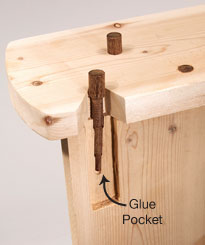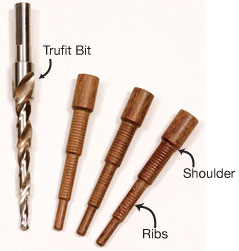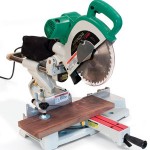We may receive a commission when you use our affiliate links. However, this does not impact our recommendations.
|
|
|
What do you get if you add the ease of a screw to the strength of a dowel? The Miller Dowel. The system is inexpensive and easy to use. Just drill a hole, glue and drive a peg, and cut or sand it flush. The Miller Dowel is a highly engineered peg that does more than simply dowel the joint together. It acts like a nail or screw, drawing the parts together as you tap the Miller Dowel into place. Steps are the key: The dowels are stepped, and the TruFit bit used for predrilling is stepped to match. What makes the Miller Dowel work so well is the relationship between the steps on the drill and those on the dowels. The parts are machined so the shoulder on the top will bottom out before the rest of the steps do. As you tap the head with a mallet, seating the dowel, you are actually drawing the parts together, just as the head of a nail or screw would. The dowel's ribs provide some bite into the joint and also expose end grain on the dowel.
The end grain absorbs moisture from the glue, causing the dowel to swell inside the hole. The bottom portion of the predrilled hole automatically ends up deeper than the dowel is long, creating a pocket for excess glue. The steps also allow the dowel to be pushed far into the hole before making contact. This prevents glue from being squeezed off the dowel and onto the face of your work. Finally, the steps make it very easy to drive a long dowel into a perfectly fitted hole—something that's very difficult to do with straight dowels.The most cumbersome aspect of using this system is clamping all the parts together for drilling, but you would run into the same problem using screws. The Miller Dowel is designed for butt or lap joints where you might otherwise use screws and plugs. It's great that the holes are automatically plugged, but unlike custom-cut plugs placed over screws, the Miller Dowel leaves end grain exposed instead of face grain, which will finish differently than the surrounding wood. Predrilling can be done using a hand drill. In fact, holes drilled at a slight angle, a common side affect of handheld drilling, create a toenailed effect that helps hold the parts together. Miller Dowels are available in three sizes, the Mini-X designed for 1/2-in. material, 1X for 3/4-in. material and 2X for 3/4- to 1-3/4-in. material. Each size requires its own drill bit. The dowels can be purchased in a variety of species, including birch, cherry, walnut, oak, ipe and teak. Ipe and teak are excellent choices for an outdoor project. Prices vary depending on the dowel species.
Sources
Miller Dowel Co., (866) Wood-Peg, www.millerdowel.com, Miller dowels: Mini-X dowels, birch, 100 for $14
1X dowels, birch, 40 for $9, 2X dowels, birch, 40 for $11, Mini-X TruFit bit, $10, 1X TruFit bit, $17, 2X TruFit bit, $18, Kits: Mini-X kit with TruFit bit and 100 birch dowels, $23, 1X kit with TruFit bit and 50 birch dowels, $25
2X kit with TruFit bit and 50 birch dowels, $30.
Here are some supplies and tools we find essential in our everyday work around the shop. We may receive a commission from sales referred by our links; however, we have carefully selected these products for their usefulness and quality.











